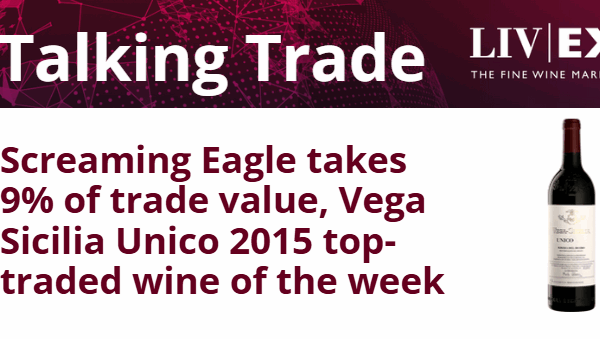What’s happening in the market?
Vega Sicilia, Unico 2015 is the top-traded wine of the week so far by value, leading Spain’s share of the market up to 19.7%. As it stands, the region is ahead of Burgundy as the second top-traded region of the week.
Pavie 2021 is the second top-traded wine of the week, changing hands at its lowest ever price (£1,230 per 12×75), 55% below its ex-London release. There are a further eight cases available on the exchange at this price.
Today’s deep dive: Trade vs. Market Prices – when and why do they diverge?
In better market conditions, trades execute closer to Market Price. Intuitively, this makes some sense: in upward moving markets, bids are drawn up to meet offers, while in down markets, offers are drawn down to meet bids. As trade prices rise, so too does Market Price, as merchants seek to either maintain or increase their margins.
Still, the breach above the zero line (buying above market) may strike as improbable or, at least, irrational. Trade vs. Market Prices of Chateau Lafite Rothschild 2016 over the same period provide an example of how this interaction occurs in practice.
Liv-ex trades of Lafite 2016
While prices are rising, buyers are keen to enter the market, under the assumption that, even if they are buying above Market Price, they will see returns on their investment. It may also be more difficult — or perceived as more difficult — to obtain highly in-demand wines. As the market begins to lose confidence in the price, trade becomes sparse, and sellers decide to exit their positions. Market Price remains high for a touch longer, before stockholders begin to compete. Unsurprisingly, merchants are slower to drop their list prices on the way down than they are to raise them on the way up, creating a lag between trade and market prices. Now, trade prices are stabilising, indicating that buyers and sellers are better aligned on value – buyers feel more confident to purchase close to Market and sellers are no longer overly keen to exit their positions.
Though not a perfect measure, proximity of trades to Market Price can provide some insight into market sentiment. Returning to the first chart, the optimism characterising Q1 2025 (prior to Trump trade wars) is clear. The dip in May, marking a new low, is equally clear, with US buying habits suffering the greatest change. Promisingly, however, average % to Market Price has bounced back up in recent weeks.
The impact of US buyers
US buyers tend to purchase closer to Market Price than other regional segments. With the average US Benchmark for the Liv-ex 1000 sitting 33.9% higher than Market Price, they can afford to be highly competitive with their bids, transacting quickly and selling for a profit in the US.
Fluctuations can largely be explained by changes in the GBP:USD exchange rate, which itself has hinged upon tariff announcements. When the Dollar strengthens against Pound Sterling, US buyers can purchase at or above Market Price while retaining their domestic margins. Bids close to Market Price effectively prop up trade prices, providing a higher floor. It is no surprise, then, that May, following not only the threat of tariffs but a real devaluation of the Dollar, brought with it some of the sharpest index declines since the turn of the market. As the market comes to terms with a (supposedly) solidified 15% tariff, a strengthening of the dollar will be in the best interests of those hoping for imminent recovery.
Liv-ex analysis is drawn from the world’s most comprehensive database of fine wine prices. The data reflects the real-time activity of Liv-ex’s 620+ merchant members from across the globe. Together they represent the largest pool of liquidity in the world – currently £140m of bids and offers across 20,000 wines.







